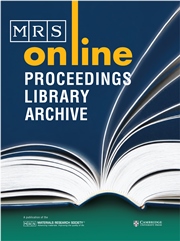Article contents
Modeling of “Pad-in-a-Bottle”: A Novel Planarization Process Using Suspended Polymer Beads
Published online by Cambridge University Press: 17 July 2013
Abstract
The “pad-in-a-bottle” (PIB) approach to planarization is a non-traditional chemical mechanical polishing (CMP) process in which slurry containing polymer beads is used. The approach is hypothesized to be able to perform polishing by mixing polymer beads with similar chemical and mechanical properties as pad asperities into the slurry to provide force application and polishing contacts, so that a traditional CMP pad is not needed. Pad-in-a-bottle could provide predictable and controllable mechanical contacts through bead size control, which could substantially reduce process variability. Pad-in-a-bottle also has the potential to reduce the CMP consumable cost. In this work, we propose a physical model to understand the behavior of the pad-in-a-bottle approach and estimate the relationship of applied pressure and material removal rate in this variant of CMP. Two specific cases of polymer bead formation are considered in our modeling work, bead packing and bead stacking. Model prediction shows that the two bead formation cases generate distinctly different polishing mechanisms: material removal is applied pressure driven in bead packing, but contact event driven in bead stacking. The physical model suggests that in future experiments or applications of pad-in-a-bottle, a polymer bead size distribution or shape variation may be needed to achieve efficient material removal.
Keywords
- Type
- Articles
- Information
- Copyright
- Copyright © Materials Research Society 2013
References
REFERENCES
- 1
- Cited by




